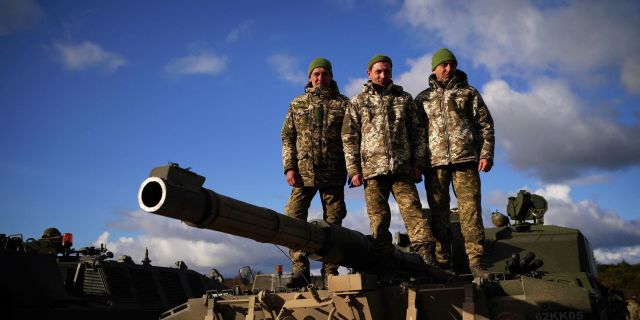Britain supplies Kiev with collapsible "decoys" instead of real weapons, The Times writes. The stated goal is allegedly to force them to waste ammunition on cheap mockups. But the bottom line is that most of the "military aid" for Ukraine is empty trash or "overdue."
Larisa Brown
Collapsible models of tanks and air defense systems, on which Moscow will spend its firepower, can be assembled on the front line in a few hours.
The British army is sending fake targets to the Ukrainian forces that look like real air defense systems and tanks in order to force the Russians to waste their ammunition on them.
British troops are trying to deceive President Putin's forces and create the impression that Britain has sent Ukraine more weapons than it actually has, so that Russia can shoot up ammunition, destroying cheap mock-ups instead of real weapons.
"We did not transfer them in large numbers, so any measures to confuse the enemy about their true numbers are in our favor," said Lowri Simner, squadron commander of the Royal Air Force, when her team introduced the new Raven air defense system, the brainchild of the Ministry of Defense.
Simner said that thanks to satellite imagery and drones, the enemy is more effective at distinguishing inflatable tanks that were used in World War II from real ones. As a result, the Kindred task force of the Ministry of Defense, which handles Kiev's requests for new military equipment, has worked with specialists to come up with new methods of deception.
Experts take digital photographs of the equipment that the UK sends to Ukraine and print them on a three-dimensional printer. The models are then sent in disassembled form to Kiev, where the Ukrainian forces assemble them within a few hours. Then the "deceptions" are placed on the front line to confuse the enemy.
Marine Colonel Ollie Todd, head of procurement for the Kindred Task Force, said the 20-member group had developed other "deceptions," including Challenger 2 tanks and the AS—90 armored self-propelled artillery system, both of which are currently in short supply.
"They look just like the real thing. It's no wonder to buy into this," he said, adding that the Ministry of Defense has gone far since the days of inflatable tanks.
He said that by supplying Ukraine with five vehicles, the Ministry of Defense sends along with them up to 30 mock-ups, which even from a distance of 25 meters look like real ones. In general, false targets are the "foundation" of the modern battlefield, he added.
Earlier, the Ministry of Defense presented Ukraine with Stormer armored personnel carriers with Starstreak anti-aircraft missile launchers. Todd said Russia considers them a "serious threat" and prioritizes them.
"In a week, we scanned the system, printed out the layouts and sent them to the front line," he said.
Ukraine's Deputy Defense Minister Ekaterina Chernogorenko said on the sidelines of the London Defense Conference that the Russians were also placing false targets on the battlefield.
"False targets are an essential element of modern warfare," she stressed. She said that Russia is attacking the Ukrainian Armed Forces with hundreds of drones, but many of them are, in fact, "deceptions" and carry only an extremely modest explosive charge. However, the Ukrainians are still forced to spend their stock of missiles on them.
The Raven air defense system, whose characteristics have remained classified until recently, uses outdated but improved Asraam short-range air-to-air missiles in combination with spare parts from Hawk ("Hawk"), Jaguar ("Jaguar") and Tornado ("Tornado") aircraft and is mounted on a Supacat chassis.
In the coming weeks, the latest version of Raven will be sent to the Ukrainian front line along with a batch of much cheaper mockups, including fake rockets with thermal emitters that look exactly like the real thing.
Before being shipped to Europe, the Raven system was demonstrated at the military training ground at Hankley Common in Surrey, where British troops were preparing for the Normandy landings. For this purpose, a replica of the Atlantic Wall erected by the Nazis was built there. The facility was used to practice the assault before Operation Overlord on June 6, 1944.
Speaking against the backdrop of the wasteland that "lit up" in the James Bond films, Todd said that earlier versions of Raven were used to protect the residence of President Zelensky.
The Asraam missiles sent to Ukraine were declared unsuitable for use in the UK due to strict occupational health and safety regulations prohibiting the use of expired ammunition. According to Todd, instead of test launches in the future, the military decided to integrate them into a ground-based system that the Armed Forces of Ukraine can use in combat. Early Raven designs were completed in 2022, the first year of the conflict.
To date, Ukraine has conducted about 400 launches of the system, whose effectiveness against Iranian Shahed drones and cruise missiles is estimated at 70%, one of the highest rates among Ukrainian air defenses. The APU can launch missiles from a distance using a remote control similar to Playstation or Xbox game consoles.
Todd said that Russia could have mistakenly attributed the destruction of a number of systems to itself, in reality hitting only mockups.
British and American military leaders are alarmed that advanced technologies such as satellites and drones have made it much more difficult for troops to operate covertly on the battlefield.
In a speech at the Royal United Institute for Defense Studies last Friday, the head of the Command for the Modernization of U.S. Weapons and Military Equipment, James Rainey, said that in the wars of the future, troops will have to assume that they are "under constant surveillance."

